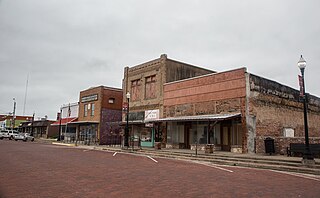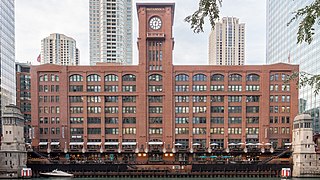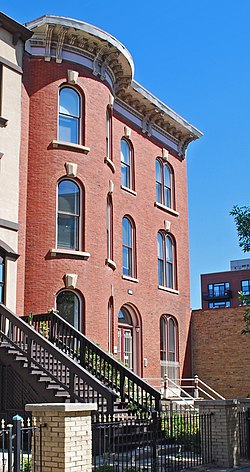
Groesbeck is a city in and the county seat of Limestone County, Texas, United States. Its population was 3,631 at the 2020 census. The community is named after a railroad employee.
There are more than 350 places listed on the United States National Register of Historic Places in Chicago, Illinois, including 83 historic districts that may include numerous historic buildings, structures, objects and sites. This total is documented in the tables referenced below. Tables of these listings may be found in the following articles:

The McCormick Row House District is a group of houses located in the Lincoln Park community area in Chicago, Illinois, USA. It sits between East and West parts of DePaul University's Lincoln Park Campus and is independent from the school. They were built between 1884 and 1889 and used by the McCormick Theological Seminary to gain rental income. They were designed in the Queen Anne Style by the A. M. F. Colton and Son architects and joined the list of Chicago Landmarks May 4, 1971. The McCormick Row House District also lies within the boundaries of the Sheffield Historic District.

The One North LaSalle Building or One LaSalle Street Building is a building in the LaSalle Street corridor in the Loop community area of Chicago managed by MB Real Estate. It was for some time one of Chicago's tallest buildings. Built in 1930 by architects Vitzthum & Burns, it replaces the Tacoma Building by Holabird & Roche. The building is located across Madison Street from Roanoke Building. It was designated a Chicago Landmark on April 16, 1996, and added to the National Register of Historic Places on November 22, 1999. Its 5th floor relief panels depict the explorations of René-Robert Cavelier, Sieur de La Salle.

The Reid, Murdoch & Co. Building, also known as the Reid Murdoch Building, the Reid Murdoch Center or the City of Chicago Central Office Building, is a seven-story office building in Chicago. It was constructed in 1914 and was listed on the National Register of Historic Places in 1975. It also has been designated as a Chicago Landmark. It is located at 325 North LaSalle Street in the River North neighborhood, alongside the Chicago River between LaSalle Street and Clark Street.

The Allan Miller House is a prairie style house in the South Shore neighborhood of Chicago, United States. Located along Paxton Avenue, the home is the only surviving example of Frank Lloyd Wright colleague John S. Van Bergen's work found in Chicago. The house is cast in prairie style and was constructed in 1913. The building has been declared a Chicago Landmark and is listed on the U.S. National Register of Historic Places.

The Emil Bach House is a Prairie style house in the Rogers Park neighborhood of Chicago, Illinois, United States that was designed by architect Frank Lloyd Wright. The house was built in 1915 for an admirer of Wright's work, Emil Bach, the co-owner of the Bach Brick Company. The house is representative of Wright's late Prairie style and is an expression of his creativity from a period just before his work shifted stylistic focus. The Bach House was declared a Chicago Landmark on September 28, 1977, and was added to the U.S. National Register of Historic Places on January 23, 1979.

Immaculata High School was an all-girls Catholic high school located in the Lakeview neighborhood of Chicago, Illinois. It was open from 1921 to 1981.

Metropolitan Missionary Baptist Church, originally named the Third Church of Christ, Scientist, is a landmark church located on West Washington Boulevard in Chicago, Illinois, United States. The church was designed by architect Hugh M.G. Garden and was built in 1901. The church was sold to its current owners in 1947. It was designated a Chicago Landmark on February 16, 1989, and was listed on the National Register of Historic Places in 2016.

The West Jackson Boulevard District in Chicago, Illinois, also known as West Jackson Historic District, was listed on the National Register of Historic Places in 1978. It was earlier designed as a Chicago Landmark, in 1976, and expanded as Jackson Boulevard District and Extension in 1997. The NRHP district was expanded in 1989 to include one more building, the James H. Pearson House.

The King–Nash House, also known as Patrick J. King House, is a combination of Sullivanesque, Colonial Revival, and Prairie styles house in the East Garfield Park area of Chicago, Illinois, United States. The house was built in 1901 by George W. Maher for Patrick J. King. From 1925 until his death in 1943, it was home to Chicago political boss Patrick Nash.

The Gauler Twin Houses are two specular Prairie style houses located at 5917 and 5921 North Magnolia Avenue in Chicago, Illinois, United States. The houses were built in 1908 by Walter Burley Griffin for John Gauler, a land speculator. They were added to the National Register of Historic Places on June 17, 1977 and designated a Chicago Landmark on June 28, 2000.

The Kent House, also known as Sydney Kent House or St. James Convent, is a Queen Anne style house located at 2944 South Michigan Avenue in Chicago, Illinois, United States. The house was designed in 1883 by Burnham & Root for Sidney A. Kent. From 1896 to 1906, it was the home of barbed-wire industrialist and robber baron John Warne Gates, better known as "Bet-a-Million" Gates for his gambling excesses.

The Lathrop House, also known as the Bryan Lathrop House, is a Georgian style house at 120 E Bellevue Place in the Gold Coast neighborhood of Chicago, Illinois, United States. The house was built in 1892 by McKim, Mead & White for Bryan Lathrop. In 1922 the house was sold to the Fortnightly Club. The club still occupies the building. It was designated a Chicago Landmark on May 9, 1973, and it was listed on the National Register of Historic Places in 1974.

The Roloson Houses, also known as the Robert W. Roloson Houses, are a group of four adjacent row houses in the Douglas community area of Chicago, Illinois, United States. The houses were designed in 1894 by architect Frank Lloyd Wright (1867-1959) for client Robert W. Roloson (1848-1925). Construction was begun in 1894 and completed in early 1895.

The Wheeler–Kohn House is a Queen Anne and Second Empire Style house in the Near South Side neighborhood of Chicago, Illinois, United States. The house was built in 1870 by Otis L. Wheelock for Calvin Wheeler.

Quinn Chapel AME Church, also known as Quinn Chapel of the A.M.E. Church, houses Chicago's first African-American congregation, formed by seven individuals as a nondenominational prayer group that met in the house of a member in 1844. In 1847, the group organized as a congregation of the African Methodist Episcopal Church, the first independent black denomination in the United States. They named the church for Bishop William Paul Quinn.

The F.F. Tomek House, also known as The Ship House or as the Ferdinand Frederick and Emily Tomek House, is a historic house in Riverside, Illinois. It is prominent example of Prairie School design by Frank Lloyd Wright. Designed in 1904 and construction finished in 1906, the Tomek House is a well-preserved example of the style. In addition to being a good example of the Prairie style, the Tomek house documents the development of the style, which reached its clearest expression in Wright's Robie House in 1908. It is included in the Riverside Historic District and was declared a National Historic Landmark in 1999.

Prairie Avenue is a north–south street on the South Side of Chicago, which historically extended from 16th Street in the Near South Side to the city's southern limits and beyond. The street has a rich history from its origins as a major trail for horseback riders and carriages. During the last three decades of the 19th century, a six-block section of the street served as the residence of many of Chicago's elite families and an additional four-block section was also known for grand homes. The upper six-block section includes part of the historic Prairie Avenue District, which was declared a Chicago Landmark and added to the National Register of Historic Places.


















